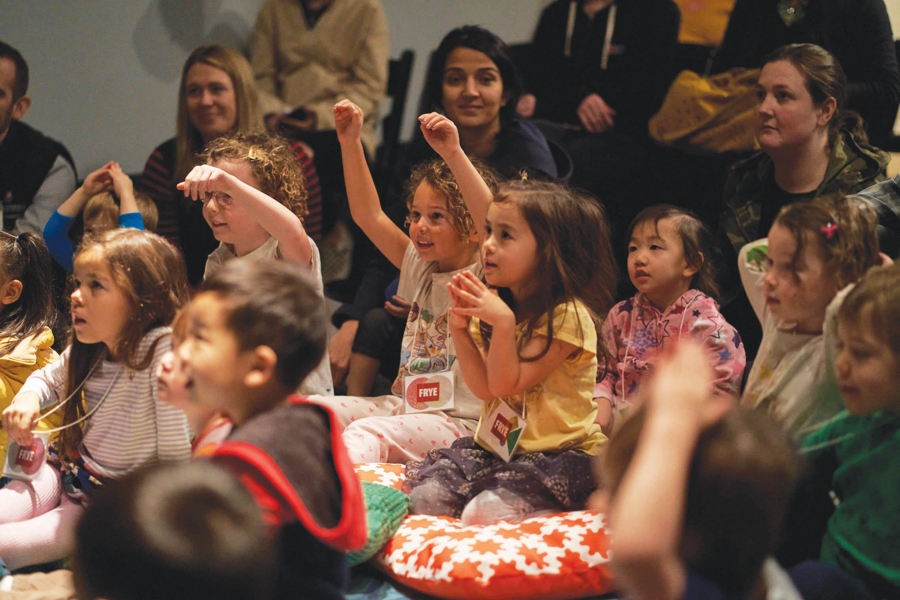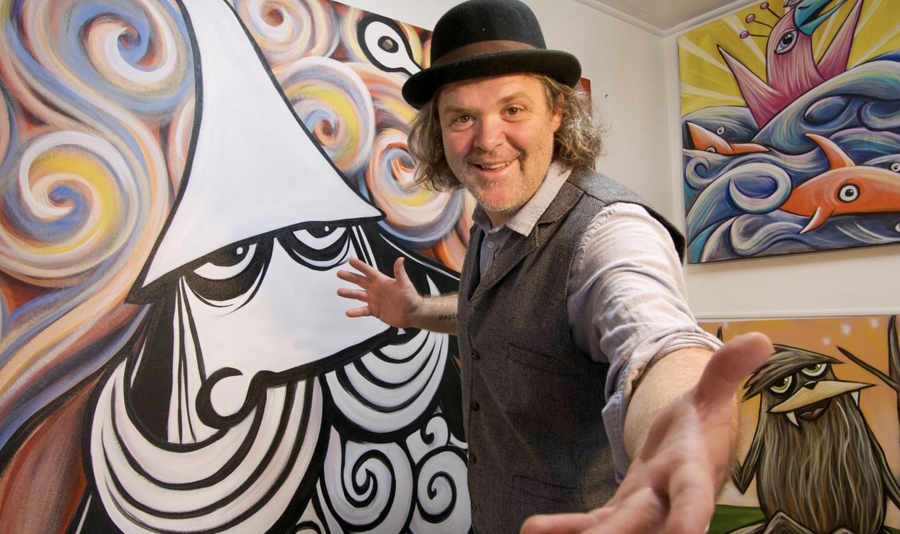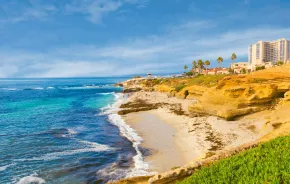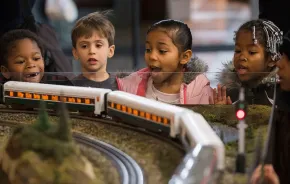
Photo:
“Fantasy: Worlds of Myth and Magic” at MoPOP. Photo courtesy of mopop.org
Unfortunately, even the term “fine art” contributes to the belief that the arts are not for everyone, and art is often the first thing cut when school budgets are tight (which is always). Fortunately, our local art institutions put a lot of thought and effort into making sure that families feel welcome. With a little planning, you can even visit most of our art museums for free.
And that’s because art is for everyone.
Seattle Art Museum
With three locations, Seattle Art Museum (SAM) is an obvious starting point for families, whether you’re local or visiting from out of town. The downtown building is just a block away from Pike Place Market, and it most closely resembles what you’re probably thinking of when you hear the words “art museum.” Reviewing SAM’s social narrative page is a great way to familiarize yourself and your kids with what to expect — and what is expected of you — during a visit to the museum.
As with most art museums, SAM requires children younger than 14 to stay with their parents at all times to ensure that behavior standards are met, but those standards really are not that strict. As when visiting someone’s home, guests should not run around, shout or touch things without permission. To protect the artwork, food and drinks are banned from most gallery spaces, but there are dedicated areas away from the art where families can take a snack break.
The Seattle Asian Art Museum (SAAM), located in Volunteer Park, is home to the museum’s extensive collection of both historical and contemporary Asian art. Instead of being arranged chronologically or by country of origin, SAAM’s galleries are creatively organized by themes that make for a much more interesting viewing experience. SAAM also has a social narrative to help prepare families for their visit. For both locations, there are several ways to save on admission.
SAM’s third location, the Olympic Sculpture Park (OSP), is for everyone who wants to enjoy large-scale art outdoors. It fills 9 acres at the north end of Seattle’s waterfront and is open and free every single day of the year.
Family Saturdays, for kids ages 2–12 on the first Saturday of the month, rotate among the three locations (free at SAM and OSP, and free with admission at SAAM). Community Celebrations are free, all-ages events with activities and performances centered on cultural holidays.
The Seattle Art Museum is the biggest art museum in the area, but it’s far from the only one. And there’s something for families to enjoy at all of them. Consider checking out these other museums with your kids anytime you need a bit of inspiration.
Frye Museum
Admission is always free at the Frye! Based on an original collection of traditional European art, the rest of the museum is dedicated to a cutting-edge collection of contemporary art exploring the big issues of our time. To make this dual collection more accessible to families, the museum offers Small Frye Storytelling and Art and Family Field Trips programs. Sign up for the Frye newsletter to be the first to hear about family programming.

Henry Art Gallery
Located on the University of Washington (UW) campus, the Henry is dedicated to contemporary art — which is often less challenging for children than for their parents. Exhibitions are often multimedia in nature, with elements that encourage viewers to move around (still no touching, though!) to experience the pieces fully. Admission is always free for children. Online, Henry for Families presents art activities to do at home and a “How It Works” video series. During the UW’s annual Family Weekend (Nov. 1–2 in 2024), the Henry offers all-ages programming that includes workshops and a scavenger hunt.
Bainbridge Island Museum of Art
If you’re taking a family day trip to Bainbridge Island, don’t just breeze past the art museum when you get off the ferry. This small museum with free admission and free parking won’t test the attention spans of even younger children. Its local focus means that families may recognize artists whose works they’ve seen around town, and a healthy sculpture collection (although this is also hands-off) makes the space more engaging for kids. The Artists’ Book Collection room will inspire kids to make their own books by hand. (For a closer look, join one of the regular tours or watch some of the videos online that examine the books in detail.)
Chihuly Garden and Glass
A glass museum might seem like the last place you’d want to take kids, and it’s true that there’s not much here in the way of family programming. But kids seem to be naturally drawn to the Seussian quality of Chihuly’s glass sculptures. If you’re nervous about the temptation to touch, a stop at Seattle Center’s Artists at Play playground can help kids get the wiggles out before visiting the museum.
Tacoma Art Museum
Tacoma Art Museum (TAM) offers a social story that parents can review with kids as a way to help set expectations before their visit. TAM’s online Tips page offers ideas for helping your children engage with what they see in the galleries. Once you arrive, TAM Studio is full of activities, art supplies and books related to the exhibitions. The museum partners with Tacoma Public Library for a monthly second-Saturday Studio and Storytime for kids ages 2–8. Subscribe online to TAM’s Education and Family Programming newsletter for updates.

MOPOP
Even though Andy Warhol and friends blew up the idea of fine art in the 1960s, we still sometimes forget that art means more than oil paintings. Fortunately, Seattle is home to one of the world’s foremost pop culture museums. From music to science fiction and temporary exhibitions covering all kinds of art, there is something to tickle every fancy at MOPOP. (On Oct. 11, an exhibit of Keith Haring’s work, “Keith Haring: A Radiant Legacy,” opens. Kids will love Haring’s stick figures, but his mature themes and imagery might not be right for every family.) Add in the Sound Lab, where kids can make their own music and interactive multimedia exhibits (including video games), and you’ve got yourself a family-friendly museum.
Cultural museums
When your family isn’t quite up for visiting an entire art museum, there are art exhibits within a different type of museum that can offer bite-size exposures to art. The National Nordic Museum hosts an ongoing rotation of exhibitions from Nordic artists; starting on Nov. 8, it will present “Fischersund,” an immersive multimedia exhibition about plants, created by Jónsi of the renowned Icelandic band Sigur Rós. The Northwest African American Museum is exhibiting art by one of the premier painters of the 20th century, Jacob Lawrence, who lived in Seattle for many years. Another exhibit, called "Freedom of Expression,” showcases the creative range of an evolving roster of local Black artists. Both museums host regular story times. Wing Luke Museum is presenting the work of three Japanese artists who painted scenes of Seattle before WWII. You can even find the arts at the Museum of History & Industry; for example, the recent “100 Years of Junior League of Seattle: Explore the Northwest Art Project” exhibit.
Murals and public art
Not all art is enclosed in a museum. Turn those rare sunny winter days into a citywide scavenger hunt looking for Henry’s quirky murals, or follow the Trollmap to see Thomas Danbo’s larger-than-life wooden trolls. (To round out the troll theme, you may also want to visit the old troll under the Fremont Bridge.) Use the Do206 public art guide, or see how many of downtown’s more than 50 new murals you can find. Most of them were painted as part of the Hope Corps Downtown Mural Project. The City of Seattle provides apps and maps organized by neighborhood to help you find public art wherever you want to explore. Other cities, including Bellevue, Tacoma and Shoreline, also maintain online guides to their public art, as does King County. If you want someone else to do the planning, you can take a Street Hues urban art tour of Seattle, or a tour focused just on Henry’s murals.
Whatever your family’s tastes and interests, you don’t have to look far to find art that’s engaging and fun. Because art is for everyone.












